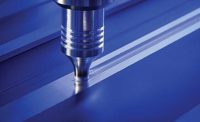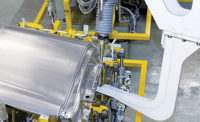If you were ever in the Boy Scouts, you probably learned how to start a fire with a wooden drill and a bow. Rapidly rotating the drill against a wooden hearth, under pressure, generated enough heat through friction to set tinder smoldering and thus, start a fire.
Rotary friction welding works in the same way. One metal component is rotated against a fixed component under pressure. Friction between the two parts removes surface oxides and heats the metal in the joint zone to the plastic state. As the parts begin to upset, the metals share electrons and bond to each other. The rotation stops, additional axial force is applied, and the weld is accomplished.
The weld is characterized by the absence of a fusion zone, a narrow heat-affected zone, and flash surrounding the joint. The weld covers the entire joint surface and is airtight.
"Friction welding is something of a misnomer, as the process forms a bond without melting the materials to be joined," says Jeff Price, manager of North American operations for Thompson Friction Welding (Sterling Heights, MI). Instead, like ultrasonic metal welding, friction welding brings the metals into intimate contact and creates a true intermolecular bond.
Rotary friction welding is used to assemble large parts, such as truck axles, and small parts, such as engine valves.
Compared with other welding methods, the process has several advantages, says Scott Hollett, vice president of sales and marketing for Inertia Friction Welding (South Bend, IN). It does not require filler metals, fluxes or shielding gases. It can join both similar and dissimilar metals, and it’s highly repeatable.
From a design standpoint, rotary friction welding enables manufacturers to replace complex forgings and castings with assemblies of less expensive bar and tube stock. Similarly, manufacturers can save material costs by using expensive metals, such as tool or stainless steel, only where they are needed.
Rotary friction welding can join most steels, including carbon steel, through-hardened steel, stainless steel and tool steel. It also works with nonferrous metals, including nickel alloys, titanium, copper and aluminum. "Metals with slippery characteristics, such as cast iron, are hard to join with friction welding," says Hollett.
The sole prerequisite for rotary friction welding is that at least one of the parts must be round. However, because the heat for the process is generated by friction, part size can be an issue. Rotary friction welding can join parts as small as 4 millimeters in diameter.
"Friction is a function of surface area and speed," Hollett explains. "As the diameter of the part decreases, the speed at which it must be rotated increases. Most parts can be welded at a speed of 5,000 rpm or less, but little parts might need 40,000 or 50,000 rpm."
Additionally, the parts must be strong enough to endure the forces associated with clamping, spinning and forging. "Tubing with extremely thin walls would be difficult," says Hollett.
The Process
There are two types of rotary friction welding: inertia and direct-drive. In inertia welding, the rotating part is clamped to a flywheel. The size of the flywheel varies with the size of the part. The flywheel is rotated to a set speed and disengaged from the motor. The parts are then brought together under axial pressure, and rotation stops naturally as energy from the flywheel dissipates.In the direct-drive method, also known as the continuous drive method, the rotating part is clamped directly to the motor. The parts are brought together under axial pressure. When the metal at the joint interface reaches plastic temperature, the motor is stopped and forging pressure is applied.
A variation of the direct-drive method—the hybrid method—relies on servo controls to mimic the gradually decreasing speed of the flywheel.
Whether one method is better than the other is a matter of debate. There are fewer variables to control with inertia welding, and there’s no clutch or brake to wear out. Weld Arial are shorter, and the heat-affected zone is narrower.
On the other hand, rotational speeds and welding forces are lower with the direct-drive method. Direct-drive provides better control over the length of the finished part, and the angular orientation of the parts can be controlled within less than 1 degree. And, assemblers do not have to change a flywheel when changing parts.
Either way, the machines look the same—like a lathe in a machine shop. One part is inserted into the chuck of the spindle. The other is held in a fixture secured to a sliding bed. A hydraulic cylinder pushes the bed to apply the forging pressure.
"Generally, you put the shortest part into the chuck, but it’s not a hard-and-fast rule," says Hollett. "In a tube-to-plate application, for example, you’d rotate the tube."
Both the chuck and the fixture are flexible enough to handle a family of similar sized parts, but big differences will require tooling changes.
Parts can be loaded and unloaded manually, or automatically with a robot. In some cases, two welds can be done simultaneously.
The parts do not have to be finish-machined prior to welding. For example, saw-cut parts can be welded without additional processing. "If a forging has some mill scale on it, that’s OK," says Hollett. "It’s nice if the parts are clean, but it’s not critical."
The key variables in friction welding are rotation speed, time, pressure and displacement, or how far the parts are pushed together. Today’s welding machines are equipped with sensors and computer controls to monitor each variable. How tightly these parameters are controlled depends on the assembly. "The tolerances for a bicycle fork will be a lot wider than the tolerances for the turbines in a jet engine," says Hollett.
Parts joined with rotary friction welding will have flash around the joint circumference. Though flash does not functionally affect the joint, it can be an aesthetic concern. Most suppliers can incorporate flash removal systems into their equipment.
The total cycle time for rotary friction welding depends on the size of the assembly. "If you’re welding engine valves, you can do one every 3 seconds with automatic loading," says Hollett. "If you’re welding truck driveshafts, you can do one every 18 seconds, including loading and flash removal."
Supplier List
Inertia Friction WeldingSouth Bend, IN
800-439-0042
www.ifweld.com
Serva-Tech Systems Inc.
Dousman, WI
262-965-5010
www.frictionwelding.com
Thompson Friction Welding
Sterling Heights, MI
810-795-7000
www.tfwusa.com


